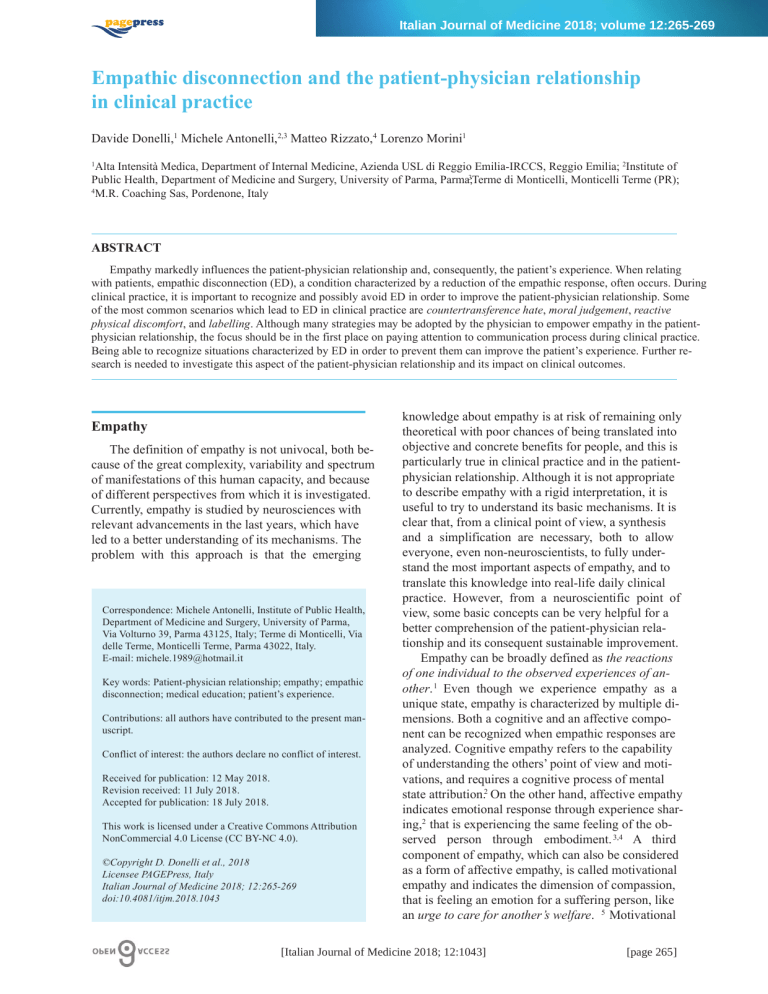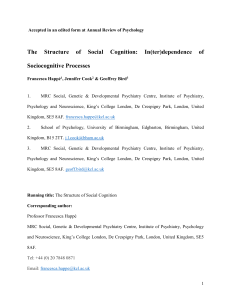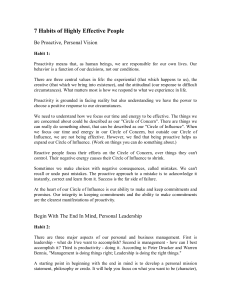caricato da
common.user1168
Empathic disconnection2

Italian Journal of Medicine 2018; volume 12:265-269 Empathic disconnection and the patient-physician relationship in clinical practice Davide Donelli,1 Michele Antonelli,2,3 Matteo Rizzato,4 Lorenzo Morini1 Alta Intensità Medica, Department of Internal Medicine, Azienda USL di Reggio Emilia-IRCCS, Reggio Emilia; 2Institute of Public Health, Department of Medicine and Surgery, University of Parma, Parma;3Terme di Monticelli, Monticelli Terme (PR); 4 M.R. Coaching Sas, Pordenone, Italy 1 ABSTRACT Empathy markedly influences the patient-physician relationship and, consequently, the patient’s experience. When relating with patients, empathic disconnection (ED), a condition characterized by a reduction of the empathic response, often occurs. During clinical practice, it is important to recognize and possibly avoid ED in order to improve the patient-physician relationship. Some of the most common scenarios which lead to ED in clinical practice are countertransference hate, moral judgement, reactive physical discomfort, and labelling. Although many strategies may be adopted by the physician to empower empathy in the patientphysician relationship, the focus should be in the first place on paying attention to communication process during clinical practice. Being able to recognize situations characterized by ED in order to prevent them can improve the patient’s experience. Further research is needed to investigate this aspect of the patient-physician relationship and its impact on clinical outcomes. Empathy The definition of empathy is not univocal, both because of the great complexity, variability and spectrum of manifestations of this human capacity, and because of different perspectives from which it is investigated. Currently, empathy is studied by neurosciences with relevant advancements in the last years, which have led to a better understanding of its mechanisms. The problem with this approach is that the emerging Correspondence: Michele Antonelli, Institute of Public Health, Department of Medicine and Surgery, University of Parma, Via Volturno 39, Parma 43125, Italy; Terme di Monticelli, Via delle Terme, Monticelli Terme, Parma 43022, Italy. E-mail: [email protected] Key words: Patient-physician relationship; empathy; empathic disconnection; medical education; patient’s experience. Contributions: all authors have contributed to the present manuscript. Conflict of interest: the authors declare no conflict of interest. Received for publication: 12 May 2018. Revision received: 11 July 2018. Accepted for publication: 18 July 2018. This work is licensed under a Creative Commons Attribution NonCommercial 4.0 License (CC BY-NC 4.0). ©Copyright D. Donelli et al., 2018 Licensee PAGEPress, Italy Italian Journal of Medicine 2018; 12:265-269 doi:10.4081/itjm.2018.1043 [page 265] knowledge about empathy is at risk of remaining only theoretical with poor chances of being translated into objective and concrete benefits for people, and this is particularly true in clinical practice and in the patientphysician relationship. Although it is not appropriate to describe empathy with a rigid interpretation, it is useful to try to understand its basic mechanisms. It is clear that, from a clinical point of view, a synthesis and a simplification are necessary, both to allow everyone, even non-neuroscientists, to fully understand the most important aspects of empathy, and to translate this knowledge into real-life daily clinical practice. However, from a neuroscientific point of view, some basic concepts can be very helpful for a better comprehension of the patient-physician relationship and its consequent sustainable improvement. Empathy can be broadly defined as the reactions of one individual to the observed experiences of another. 1 Even though we experience empathy as a unique state, empathy is characterized by multiple dimensions. Both a cognitive and an affective component can be recognized when empathic responses are analyzed. Cognitive empathy refers to the capability of understanding the others’ point of view and motivations, and requires a cognitive process of mental state attribution.2 On the other hand, affective empathy indicates emotional response through experience sharing,2 that is experiencing the same feeling of the observed person through embodiment. 3,4 A third component of empathy, which can also be considered as a form of affective empathy, is called motivational empathy and indicates the dimension of compassion, that is feeling an emotion for a suffering person, like an urge to care for another’s welfare. 5 Motivational [Italian Journal of Medicine 2018; 12:1043] [page 265] Brief Report empathy is the basis of compassionate caregiving. Empathy can be modulated by several factors, both contextual and intentional ones, which can enhance or retract the empathic response. Contextual factors are passive ones, like the intensity of the observed emotion, the attention focused on pain rather than on a task, the habit of inflicting pain for curative purposes, the characteristics of the context, of the observed person and of the one who empathizes. On the contrary, intentional factors require attentional effort or will: these ones are the point of view, the active effort to empathize, the reappraisal capacity to adapt the empathic response according to the other’s pain response, the degree of training in empathizing, the intention to cure or not.6-9 Empathy and empathic disconnection in clinical practice Nowadays, during their practice physicians very often have too limited time to dedicate to the relationship with patients, thus possibly determining poorer quality of experience for them. From a clinical point of view, empathy plays a crucial role in the patient-physician relationship because it has the potential to markedly influence, both positively or negatively, the patient’s experience in terms of satisfaction, compliance and outcomes.10 Empathy is so important for the quality of the patient’s experience because it is possible to transform even a brief encounter into a positive experience for the patient through an appropriate empathic relationship. Indeed, quite often retaliations are more likely to occur when this does not happen. Actually, it is the quality of time spent with the patient that really matters, although the available amount of time is limited. For example, if during a 20-min visit a physician could spend even only a few minutes giving full attention to the patient, valuing the relationship, then the patient would have a good experience. However, empathy can be a double-edged sword. As it can be determinant to greatly improve the patient’s experience, it can also cause significant personal distress for the physician if not properly integrated into healthcare. In particular, affective empathy, that can be characterized by an empathic resonance with the patient, exposes physicians to the risk of personal distress. In fact, when relating to another person, mechanisms of experience sharing basic to affective empathy imply that we feel inside ourselves, within our body, the same feeling experienced by the other person observed.9,11 The nature of this experience sharing system makes it necessary for our brain to differentiate the self from the other, and to understand, for example, that the observed (and embodied) emotion is not ours, [page 266] and comes from the other. The less our brain is capable to make a self-other distinction, the more we are exposed to the risk of personal distress from empathizing with the other. Cognitive empathy is less likely to cause distress either because of its different neural substrate, and because of its characteristic of being a cold empathy,12 well exemplified by surgical practice. Motivational empathy, or compassion, is also less likely to cause distress because, thanks to a balanced interaction between affective empathy and cognitive empathy brain circuits, it allows the comprehension of the other’s suffering, and the stemming of a new, warm and positive desire to help, without experiencing the exact same observed emotion. In the light of these considerations, it is easy to understand that physicians often need a sort of empathic defense against the patient’s emotional state.11 Accordingly, physicians may consciously or unconsciously behave in such a way as to protect themselves from prolonged exposure to the patient’s experience of suffering. Therefore, empathic defensive attitudes have a very important role since they protect the physician from an early burn-out. However, these attitudes, especially when they occur unconsciously, may impair the empathic connection with patients, which is so important to create a positive experience for them. It is fundamental to well know what determines this empathic disconnection (ED), that refers to those situations in which the empathic function is reduced.9,11 As discussed above, there are many factors that contribute to empathic modulation, either contextual or individual ones, which can enhance or retract the empathic response of an individual. These factors are tightly linked to many aspects of the patient-physician relationship, and ED can happen in different situations which may all lead to disadvantages for the patient, including feeling neglected, lost, judged, disoriented, scared, or upset. However, in our view, there are some particularly frequent patient-physician scenarios that we can experience in everyday clinical life and that are capable of determining ED. These scenarios are countertransference hate, moral judgement, reactive physical discomfort, and labelling.9 They are characterized by attitudes that are often unconscious, and, for this reason, it is crucial to be able to recognize them when they occur during clinical practice, in order to avoid an unintentional poor experience for the patient. On the one hand, physicians have the necessity to establish high-quality empathic relationships with patients within the short amount of time allocated for each visit, while, on the other hand, they are at risk of being exposed to excessive emotional distress. This situation forces physicians to develop good skills in controlling their own empathic capacities. As we can figure out on the basis of what we have previously dis- [Italian Journal of Medicine 2018; 12:1043] Empathic disconnection and the patient-physician relationship cussed, the ideal strategy for a physician would be to generate motivational empathy, or compassion, in order to set a positive empathic relationship with the patient without getting distressed. However, it may not be so easy and may require a long and specific training to become skilled in reproducing compassion in a congruent way. For this reason, we think that a first step to create patient-physician relationships with a higher empathic quality, even when the amount of time is limited, is to learn how to skillfully recognize those very frequent scenarios that are known to determine ED and cause an impairment of the quality of the relationship and of the patient’s experience. The key point is to recognize these scenarios when they happen because this would allow physicians to be conscious of their attitude, thus naturally interrupting the concomitant ED. In fact, the process of self-awareness of one’s ED would be sufficient alone to cognitively avoid emotional distress, while being more empathetic at the same time. Common scenarios determining empathic disconnection Countertransference hate Countertransference hate indicates a situation in which the physician feels aversion for the patient and, although the former apparently treats the latter as usual, a subtle emotion of intense dislike is harbored by the practitioner. 13 This dynamic, well known in psychiatric practice, should not be ignored in general clinical practice too. The physician may be aware, or unaware (which is more dangerous), of this process and, as a consequence of it, the patient instinctively reacts and tends to close off. This is likely to happen when the physician has to deal with patients who behave in a demanding, harassing or insulting way. In this case ED is caused by the perception of the patient as an aversive stimulus, which down-regulates brain areas dedicated to affective empathy, and up-regulates the activity of the reward system, thus inducing the physician to seek gratification damaging or taking revenge on the patient.9 An example may be a physician who has to check a patient who complains about waiting too long and who offensively blames on medical staff for it. The physician will be more likely to superficially assess the patient due to the triggered feeling of aversion and this may lead to less precise diagnosis and worse outcomes. addicted patient, criminal). When this happens, the patient is unlikely to set a positive and empathic relationship with the physician, and is not willing to share information because of feeling judged. Moral judgment may cause ED since the perception of another person’s life values or habits as unfair or wrong determines a down-regulation of brain areas responsible for affective empathy, as well as an up-regulation of the reward system (e.g. unconsciously figured as you’re wrong, and I feel gratified not being like you!). For example, this occurs more frequently when the patient has a disease, which is considered shameful because of its way of transmission, like sexually transmitted diseases, or because of its social stigma, like psychiatric disorders, mental retard, or drugs abuse. Reactive physical discomfort Reactive physical discomfort refers to the instinctive reaction of the physician when dealing with patients whose physical behavior is altered due to an impaired regulation of the autonomic nervous system. This is common among patients with psychiatric disorders. According to the Polyvagal Theory, the perceived safety of a situation induces a modulation of the activity of different components of the autonomic nervous system, namely the smart vagus (in situations perceived as safe), the sympathetic nervous system (in situations perceived as dangerous), and the vegetative vagus (in situations perceived as life-threatening). 15 Only when the activity of the first component is prominent, the autonomic system is set in a way which eases socialization and empathization. When the activity of the other two components is prominent, the autonomic system is set for fight-or-flight or paralyzing fear responses, hindering any effort to empathize. Reactive physical discomfort occurs when the physician experiences high levels of distress as a consequence of mirroring the patient’s altered autonomic state or because the patient’s altered control of facial expression makes the physician perceive the patient as potentially dangerous. 9 In this scenario, ED is caused by the perception of a threat, that is a fear reaction, which deprives the physician of a good motor control over the structures necessary for communication and empathization (heart rate, respiration, throat muscular control). For example, this can happen when the physician has to deal with a schizophrenic and agitated patient who can trigger discomfort because instinctively perceived as a threat. Moral judgement Moral judgement occurs when the physician judges patients according to their own belief system and cultural background. 14 It is very common when the patient is involved in some social taboo (e.g. drug- Labelling Labelling is a process in which physician’s attention focus is shifted from the patient as a whole to the patient considered as a diagnosis. When labelling oc- [Italian Journal of Medicine 2018; 12:1043] [page 267] Brief Report curs, the physician’s attention focus is not on the relationship with the patient, but on the tasks needed to manage a specific disease. This is a direct consequence of the standardized procedures to manage patients, which push physicians to adopt a standardized attitude when dealing with them. For example, a patient with liver cancer may be labeled as the liver cancer patient and treated accordingly, strictly following clinical guidelines without taking into consideration subjective aspects, which are important in determining individual quality of life and personal expectations or wishes. In this scenario, ED is likely to be caused by a shift of the attentional focus on the task to manage the patient, rather than on the relationship, determining a down-regulation of brain areas responsible for affective empathy. 9 Moreover, because of labelling, the physician is also more likely to interpret everything as a consequence of the already diagnosed disease and its complications, losing the opportunity to link them to other factors in a wider vision of the patient. This may be misleading in terms of diagnostic and therapeutic accuracy when the practitioner has to assess the patient’s health status during a middle-to-long-term follow-up. Improving empathy in the patient-physician relationship Probably, the most important way to improve the quality of empathy in the patient-physician relationship is to simply pay attention to the communication process. This attention should be, first of all, focused on learning how to be aware of some evident empathic mistakes that physicians quite often make during their clinical practice. Therefore, physicians should acknowledge the above-mentioned ED scenarios in order to possibly avoid them, since being aware of them may be sufficient to interrupt ED and set an empathic relationship without getting distressed. Yet, there may be different strategies to avoid ED and achieve better empathic relationships. Motivational empathy may be improved through meditation techniques. 16 Cognitive empathy may be enhanced through learning how to properly observe the patient’s Vitality Forms, 17,18 which are dynamic and physical reflections of a person’s emotional state expressed through the qualities of movement. If physicians were capable of interpreting these signs, they could better interpret the patient’s mood, motivations and intentions.9 Affective empathy may be improved trying to consciously create empathic moments, 9 that are brief intervals of empathic resonance, long enough to get valuable information about the emotional state of the patient without causing significant emotional distress to the physician. [page 268] However, we think that these ones are not first line strategies. The first point that physicians need to address in order to create a better relationship with their patients is to focus on the communication process and to avoid empathic mistakes that determine ED and impair the quality of the patient’s experience. This approach can be integrated into clinical practice, for example during patient’s history taking. Conclusions As we know, empathy plays a central role in the patient-physician relationship and it is necessary for physicians to learn how to properly use empathic skills. A positive and effective patient-physician relationship may be considered useful to enhance the patient’s experience, but even to improve diagnoses and outcomes. It has to be underscored that prioritizing quality will be essential in the future of medicine and one way to achieve this goal is to fully understand how empathy works and how ED occurs. Even though physician’s empathic skills may be trained and improved with different strategies, there are some very common patient-physician relationship scenarios characterized by ED that significantly impair the quality of patients’ experience. Therefore, a simple and sustainable way for physicians to improve the quality of the patient-physician relationship may be to acknowledge these common mistakes in order to avoid them during clinical practice. This will be useful to improve the patient’s health from a physical, cognitive but even emotional point of view. Further research is needed to study this aspect of the patient-physician relationship and its impact on clinical outcomes, and appropriate study designs for its investigation need to be found. References 1. Davis MH. Measuring individual differences in empathy: Evidence for a multidimensional approach. J Personal Social Psychol 1983;44:113. 2. Zaki J, Ochsner K. Reintegrating the study of accuracy into social cognition research. Psychol Inquiry 2011;22: 159-82. 3. Gallese V, Keysers C, Rizzolatti G. A unifying view of the basis of social cognition. Trends Cognit Sci 2004;8:396-403. 4. Gallese V, Sinigaglia C. What is so special about embodied simulation?. Trends Cognit Sci 2011;15:512-9. 5. Decety J, Cowell JM. The complex relation between morality and empathy. Trends Cognit Sci 2014;18:337-9. 6. Engen HG, Singer T. Empathy circuits. Curr Opin Neurobiol 2013;23:275-82. 7. Hein G, Singer T. I feel how you feel but not always: the empathic brain and its modulation. Curr Opin Neurobiol 2008;18:153-8. [Italian Journal of Medicine 2018; 12:1043] Empathic disconnection and the patient-physician relationship 8. Bernhardt BC, Singer T. The neural basis of empathy. Annu Rev Neurosci 2012;35. 9. Donelli D, Rizzato M. Empathy and empathic disconnection in difficult and uneasy situations: facing the suicidal individual. In: Phenomenology of suicide. Rome: Springer: 2018. pp 73-112. 10. Jani BD, Blane DN, Mercer SW. The role of empathy in therapy and the physician-patient relationship. Complement Med Res 2012;19:252-7. 11. Rizzato M, Donelli D. I am your mirror: mirror neurons and empathy. Torino: Edizioni Amrita; 2014. 12. Keysers C. The empathic brain: How the discovery of mirror neurons changes our understanding of human nature. Lexington: Social Brain Press; 2011. 13. Maltsberger JT, Buie DH. Countertransference hate in the treatment of suicidal patients. Archiv Gener Psychiatr 1974;30:625-33. 14. Pompili M. Our empathic brain and suicidal individuals. Crisis 2015 [Epub ahead of print]. 15. Porges SW. The polyvagal theory: neurophysiological foundations of emotions, attachment, communication, and self-regulation (Norton Series on Interpersonal Neurobiology). New York, NY: WW Norton & Company; 2011. 16. Lutz A, Brefczynski-Lewis J, Johnstone T, et al. Regulation of the neural circuitry of emotion by compassion meditation: effects of meditative expertise. PLoS One 2008;3:e1897. 17. Stern DN. Forms of vitality: exploring dynamic experience in psychology, the arts, psychotherapy, and development. Oxford: Oxford University Press; 2010. 18. Di Cesare G, Di Dio C, Marchi M, et al. Expressing our internal states and understanding those of others. Proc Natl Acad Sci 2015;112:10331-5. [Italian Journal of Medicine 2018; 12:1043] [page 269]


